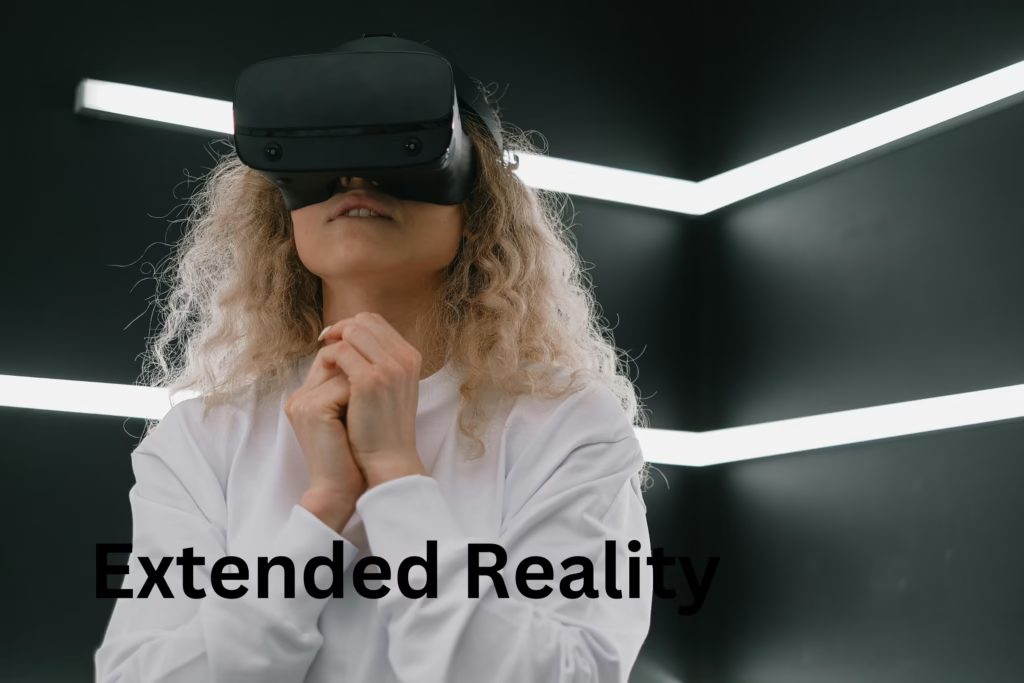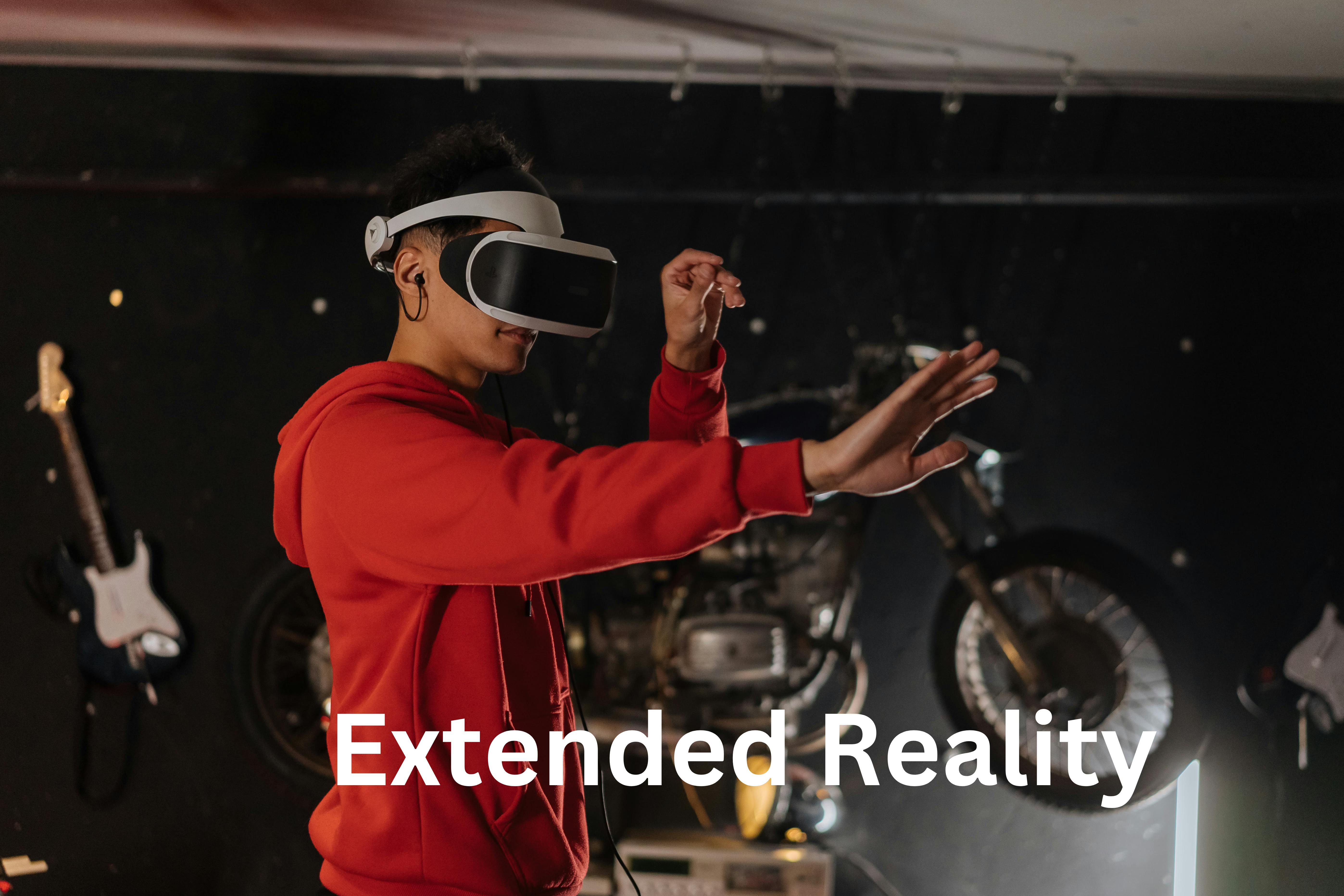Extended Reality (XR) is the future vision of Technology. What was once just limited to gaming has now spread over multiple fields, from healthcare to research and even online Shopping.
This article will discuss how XR will shape 2025 and bring us into an advanced world.

What Is Extended Reality?
Extended Reality (XR) is a sum of three parameters: –
- Virtual Reality (VR): Helps you step into a new zone and world all together
- Augmented Reality (AR): Takes up the real-life world and adds digital elements to it
- Mixed Reality (MR): Bring both VR and AR together to get the epitome of immersive technology
How XR Can Empower Communities
XR is not just significant for personal and business aspects. It even holds the key to empowering entire societies
- A bridge between cultures
XR fosters a sense of community. People can create their own communities and share their cultures all over the world.
2. Supporting Accessibility
- People can use great accessibility features to understand all the content.
- People with physical disabilities will have no hindrance to accessing virtual events
3. Crisis Management and Disaster Response
- Training First Responders: Emergency workers can practice on real life situations in an efficient way.
- Disaster Recovery Planning: XR helps plan the the recovery costs after damages have been occured
XR and Sustainable Development
Extended Reality can even be a new tool for the world’s eco-warriors in the following ways: –
- Reducing Travel
Business meetings and trade summits can all be held online to avoid unnecessary travel. We can cut down on global carbon emission levels by implementing XR
- Eco-Friendly Prototyping
Using XR, industries will not have to make physical models to experiment before launching a product. All the tests could be run in a virtual setting.
- Promoting Awareness
Using Extended Reality, we can produce real-life moving films to make people more aware of the harmful actions they sometimes incur on the environment.
Your next Space Read: https://creative-insights-aady.com/12-everyday-gizmos-made-for-space/
Preparing for the XR Revolution
Collaboration between governments, businesses, educators, and tech developers is essential to fully realizing XR’s potential.
Here’s how everyone can invest fully in XR: –
Governments
- Maintain the privacy of users and prevent sensitive information leaks
- Giving infrastructure support to grow XR by providing 5G network coverage
- Creating public awareness to highlight the uses of XR
Businesses
- Use XR to engage customers and adequately train their employees.
- Beat competition by integrating XR and enhancing their product appeal to all the users.
- Design user-friendly and engaging tools to enhance user experience.
Educators
- Extended reality can additionally be used in teaching to make it more fun and engaging.
- Teaching XR can help promote students to pick it up as a future career.
- Create awareness about ethical usage of XR to help develop a safe space for the future.
Individuals
- Be open and curious about all the new tech offered by XR.
- Work on making XR more responsible and inclusive of each culture.
- Share experiences to inspire others to adopt and experiment with XR.
Your next thriller read:
https://lotusblogfeed.blogspot.com/2025/01/a-roll-of-die.html
What’s Driving XR Forward in 2025?
Several tech advancements are consequently making XR more accessible and powerful:
1. Smarter, Sleeker Hardware
The era of heavy and bulky hardware of the past is long gone. Today’s XR is light-weight and elegant and packed with the following features:
- Crystal-clear visuals with high-resolution displays.
- Comfortable designs for extended use.
- Accurate motion tracking for smooth interactions.
- Lower costs, making XR more accessible to everyday users.
These improvements mean more people can experience XR without technical glitches or difficulties.
2. The Power of 5G
The introduction of 5G networks is indeed a game changer. Faster internet means:
- No lag, even in high traffic and multiple users.
- Streamlined access to XR content anywhere, anytime.
- Faster processing, thanks to edge computing.
Whether gaming, shopping, or learning, 5G ensures a smooth, Extended Reality experience.
3. Smarter with AI
Artificial Intelligence (AI) is making XR more interactive and personal:
- Apps can finally understand human speech and respond naturally.
- Object recognition makes AR overlays more dynamic and valuable.
- Experiences are tailored to user preferences, keeping things relevant and engaging.
With AI, XR becomes more than just tech; it becomes like your personal assistant.
What’s Holding Extended Reality Back?
Despite its exciting features, XR still faces a bit of challenges:
- High Costs: Developing XR tech and content requires significant investments, making it challenging for smaller businesses.
- Privacy Concerns: XR collects a lot of data. But we are still unsure how many people can access it or if our privacy is protected.
- Accessibility: While hardware is cheaper, not everyone can afford it or has the skills to use it.
- Physical Discomfort: Motion sickness, eye strain, and fatigue can make extended use uncomfortable.
What’s Next for Extended Reality?
XR is yet to reach its pinnacle of achievements, and the future is set to unlock multiple new features: –
- Quantum Computing: Faster processing will make XR experiences richer and more detailed.
- Blockchain: Secure transactions and identities in virtual spaces.
- Brain-Computer Interfaces (BCIs): Imagine controlling XR environments with your thoughts—no controllers needed.
- Holographic Displays: No headsets are required. Holograms will make XR even more accessible. You can ‘feel’ what you want to ‘see’.
The future of XR promises to be more connected and immersive.
Conclusion
Extended Reality (XR) has emerged from the Sci-Fi feature posters and into our reality. By implementing both AR and VR in our lives, we can transform our experiences.
Extended Reality empowers everyone, whether they are learners, educators, business professionals, or research enthusiasts. The time has come to accept this new technological change and unlock all XR’s impressive features.
Like every invention in technology, XR also has its positive and negative aspects, and we need to work together to stand up from the disadvantages. Extended Reality threatens privacy only because we are still less aware of how to implement it nicely.
We can overcome this slight inconvenience with the government’s efforts and conscious awareness. Extended reality is indeed the way we can shape our future. Or even step into past historical events. It’s like molding our reality into altogether different surroundings.
XR is the portal to dimensions across space, time, and reality.
Frequently Asked Questions
Answer: Extended Reality (XR) is a broad term that holds Virtual Reality (VR), Augmented Reality (AR), and Mixed Reality (MR). Mixing all these technologies, we get the perfect blend of immersive reality.
Answer: XR benefits various industries:
Healthcare: Enhancing medical training, diagnostics, and patient care.
Education: Creating interactive learning environments.
Retail: Offering virtual try-ons and immersive shopping experiences.
Entertainment: Redefining gaming, concerts, and storytelling.
Real Estate: Enabling virtual tours and architectural visualization.
Answer: Some of the significant challenges include:
Extreme development costs.
Privacy and data infringement concerns.
Accessibility barriers are related to less technological knowledge and awareness.
If XR is engaged for long, eye strain and motion sickness are primary health concerns.
Answer: The most remarkable shift in Extended reality has been made possible by Artificial Intelligence (AI), which has made individuals’ imaginations turn into reality. High network speeds have also enabled fast connections and interactions among users.
Answer: One can start experimenting with free AR apps on their smartphones.
To use XR in daily and professional life, we can think about how it can help us implement things in real scenarios using immersive technology.


